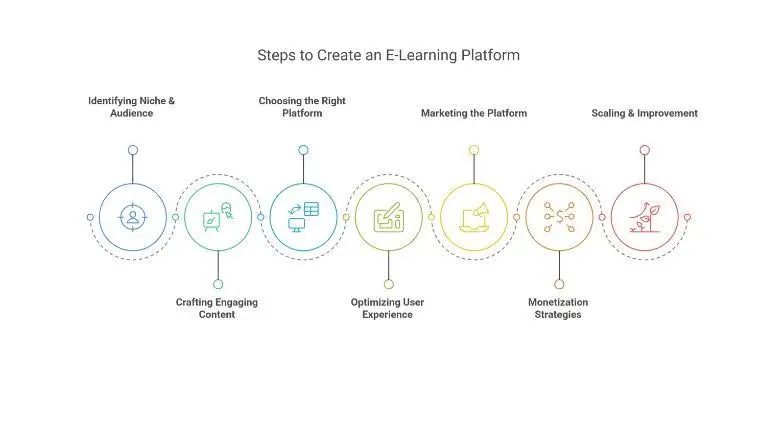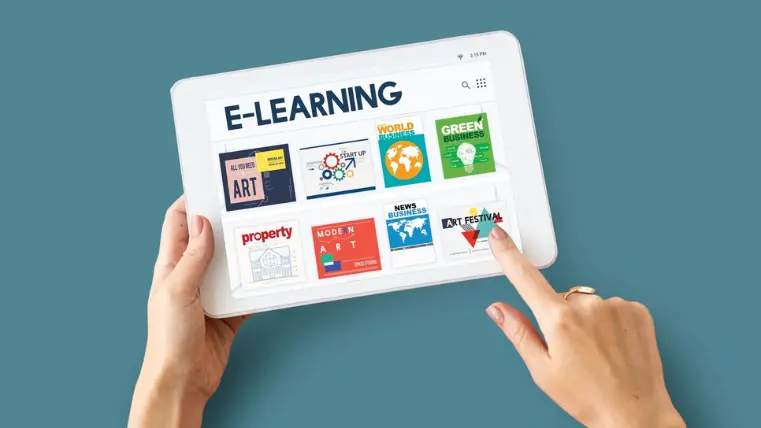India is one of the fastest-growing e-learning markets, projected to reach $18.94 billion by 2029. This growth, driven by increased internet consumption, affordable smartphones, and the shift to self-paced learning, presents a golden opportunity for creators to monetize their expertise.
Whether you’re a fitness trainer or a language tutor, launching an e-learning platform allows you to reach a larger audience, and generate passive income. With such vast potential, it’s no wonder that creators are flocking to this space to share their knowledge.
If you’re one of them, in this article, let’s figure out everything about e-learning and steps to create a successful e-learning platform.
Why Are Content Creators Turning to E-Learning?

Many creators initially share free content on platforms like Instagram, YouTube, and blogs, relying on ad revenue. However, this model is often unsustainable. As these platforms become increasingly saturated, the opportunity to make a meaningful income diminishes.
That’s where e-learning platforms come in. An e-learning platform enables creators to:
- Monetize knowledge through structured courses and memberships.
- Build a loyal community outside social media algorithms.
- Earn recurring income through subscriptions and exclusive content.
- Automate content delivery, allowing more focus on new material.
For example, a digital marketing coach can expand their Instagram tips into a full-fledged e-learning platform with step-by-step guides, templates, and certification courses. This shift not only increases revenue potential but also allows creators to develop a deeper, more engaged relationship with their students.
Common Challenges for E-Learning Creators

Creators often face hurdles like standing out in a crowded market, managing the technical aspects of their platform, keeping learners engaged, and effectively marketing their courses.
These challenges can feel overwhelming, but with the right strategies, they are entirely manageable. Here are a few common challenges that creators run into:
- High Competition: Platforms like Udemy (3.01% of market share) and Coursera (2.61% of market share) lead.
- Tech Complexity: Many creators lack the expertise to build and manage a website or Learning Management System (LMS).
- Engagement: Learners often drop out due to a lack of motivation.
- Marketing Struggles: Converting free viewers into paying customers can be difficult.
However, it’s important to remember that while these challenges exist, they are not insurmountable. By following some essential tips, you can overcome these hurdles and position yourself for success in the e-learning space.
Essential Tips for E-learning Platform Creators

This section offers key advice for creators looking to build a successful e-learning platform. It covers essential steps like defining your niche, creating engaging content, and choosing the right platform to host your courses.
Step 1: Identifying Your Niche & Audience
Success starts with choosing the right niche and audience. Focus on teaching something valuable and in demand. Without a clear focus, it can be challenging to attract learners and maintain their attention over time.
Why Niche Matters?
A well-defined niche helps you stand out. Instead of offering generic content, focus on a specific topic that matches your expertise and audience’s needs. Specializing allows you to carve out a unique space and appeal to those who are specifically looking for what you have to offer. For example:
- Fitness: Home workouts for busy professionals vs. post-pregnancy weight loss.
- Finance: Investing for beginners vs. tax-saving strategies for freelancers.
- Design: Digital art for beginners vs. advanced Photoshop techniques.
By narrowing your focus, you’ll be able to build trust and authority in a particular field, making it easier to market your courses effectively.
Defining Your Ideal Learner
To create engaging courses, it’s crucial to understand your audience’s needs. Ask yourself the following questions:
- Who are they? (Professionals, students, hobbyists)
- What are their learning goals? (Career growth, side income, personal development)
- What formats do they prefer? (Live sessions, pre-recorded courses, downloadable materials)
For instance, a digital marketing coach targeting freelancers might offer a self-paced course with weekly live Q&A sessions. On the other hand, a yoga teacher may prefer to offer a series of recorded classes paired with a live chat option. Understanding your audience’s preferences will help you design a curriculum that resonates with them.
Market Research: Finding a Profitable Niche
Conduct thorough market research is key to ensuring your niche is both profitable and sustainable,
- Analyze Competitors: Check platforms like Udemy and Coursera. See what’s working and identify gaps.
- Validate Demand: Use tools like Google Trends or run a poll on social media to gauge interest in your course.
By selecting a high-demand niche, you’ll attract engaged learners, which will also make your marketing efforts more effective. The more precise your research, the better your chances of success.
Step 2: Crafting High-Quality & Engaging Content
Creating great content is essential, but the way you present it matters too. With attention spans getting shorter, your content should be valuable, interactive, and easy to consume.
Types of Content to Keep Learners Engaged
To ensure your learners stay engaged and motivated, vary the types of content you provide. Consider using:
- Short Video Lessons: Break complex topics into digestible 5-10 minute videos.
- Live Q&A Sessions: Build a stronger connection with learners and answer their specific questions.
- Gamification: Incorporate quizzes, badges, and rewards to keep learners motivated.
- Microlearning: Offer bite-sized lessons that focus on clear, actionable takeaways.
For example, a fitness trainer might post short workout videos, while a finance coach could host live Q&A sessions to directly address questions from their audience. The more interactive and engaging your content, the more likely your learners are to stick with it and see results.
Step 3: Choosing the Right Platform
Once you’ve crafted your content, the next crucial step is selecting the right platform to host it. The platform you choose will impact your revenue, control over content, and ability to reach your target audience
Here are the three top options to choose from:
Option 1: Third-Party Platforms (Udemy, Teachable, Graphy)
Many creators start with third-party platforms because they offer ready-made solutions that are easy to use.
Pros:
- No tech headaches—upload content and start selling.
- Built-in audience (especially on Udemy & Graphy).
- Payment processing is handled for you.
Cons:
- High commission fees (Udemy takes 50% or more).
- Limited branding & customization (Your course sits among thousands of others).
- No control over student data (Platforms own the customer relationships).
Best for: Creators who want to focus solely on creating content without worrying about the technicalities.
Option 2: Building Your Own Platform (Website + LMS)
For those who want more control, hosting courses on your own website with a Learning Management System (LMS) is another viable option.
Pros:
- Full control over pricing and revenue.
- Own your email list, which means direct communication with your students.
- No competition from other courses; students focus solely on your content.
Cons:
- Requires website setup & ongoing maintenance.
- You’ll need to handle marketing and attract your own audience.
- Payment handling requires third-party integrations (Stripe, Razorpay, etc.).
Best for: Creators who are ready to invest in a long-term business and take charge of the technical and marketing aspects of their platform.
Option 3: Exly – The All-in-One Creator Platform
For creators looking for a balance between ease of use and control, Exly is a game-changer. This all-in-one platform allows you to create and sell courses without any coding skills, while offering full ownership over branding and student data.
Why Exly Works Best For Creators:
- No coding needed: Create and sell courses with zero technical skills.
- Seamless payment collection: Supports various payment methods, such as UPI, net banking, and wallets.
- Marketing automation: Run ads, send emails, and track performance.
- Full ownership: Custom branding and zero revenue-sharing.
For example, a yoga instructor could easily create an online course, automate promotions, and collect payments directly through Exly.
Best for: Creators who want more control but don’t want the tech complexity of a self-hosted website.
Step 4: Optimizing User Experience (UX)
Once your content is ready and hosted on a platform, it’s time to focus on User Experience (UX). Know that 94% first impressions are related to UX. A smooth UX ensures that learners are engaged, motivated, and likely to complete your course.
Key features to include:
- Easy Navigation: Clear and well-organized menus and course content.
- Mobile-friendly Design: Ensure your platform is optimized for mobile devices, as many users in India access content via smartphones.
- Engagement Tools: Add features such as discussion forums, live chat, and progress tracking to encourage interaction and motivate learners.
A great UX can significantly increase course completion rates. For instance, a community group on Telegram or WhatsApp can foster peer interaction and increase student engagement.
Step 5: Marketing Your e-Learning Platform
Even with great content, effective marketing is essential to make sure your platform reaches the right audience.
Here are some proven strategies:
- Instagram & YouTube Shorts: Post free tips to generate interest and drive traffic to your platform.
- LinkedIn: Share success stories and testimonials to attract professionals.
- Facebook & WhatsApp: Build communities and nurture leads through live webinars.
- Influencer Collaborations: Partner with influencers to expand your reach.
Paid ads can also be effective but start with a modest budget to test what works best for your audience. The goal is to build your audience, engage them, and convert them into paying customers.
Step 6: Monetization Strategies for Course Creators
Monetizing your platform is essential to turning your passion into a profitable business. Here are a few strategies:
- Direct Course Sales: Offer one-time payments or payment plans.
- Subscription Models: Offer exclusive content with recurring access.
- Live Cohorts & Group Coaching: Increase engagement and retention by offering live, interactive sessions.
- Corporate Collaborations: Offer tailored courses for businesses.
- Affiliate Marketing: Promote related tools and products to earn a commission.
Exploring different monetization strategies will help you maximize your revenue streams and ensure long-term sustainability.
Step 7: Scaling & Continuous Improvement
As you grow your platform, it’s crucial to continuously improve. This involves gathering feedback from students, updating content, and experimenting with different pricing models.
- Collect Feedback: Use surveys and community forums to get insights into what’s working and what needs improvement.
- Update Content: Keep your courses fresh and relevant by updating them regularly.
- Experiment with Pricing: Test different models and promotional offers.
- Leverage AI: Use chatbots and email automation to enhance user experience and save time.
Conclusion
Building a successful e-learning platform is entirely achievable with the right strategies. Start by creating high-quality content, understanding your audience, and selecting the right platform. Focus on continuous improvement, marketing, and scaling your business to turn your knowledge into a thriving online venture.
It’s not about perfection—just start and take small steps toward your goal. With the right tools and guidance, you can transform your expertise into a successful e-learning business.
Now that you have the blueprint for creating a successful e-learning platform, it’s time to act! Start building your e-learning platform with Exly today and turn your knowledge into a thriving online business.





